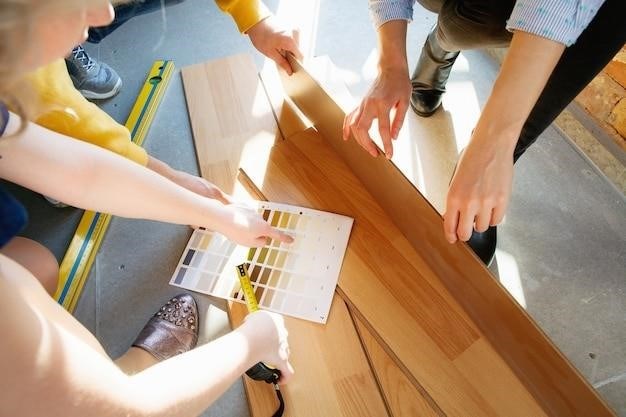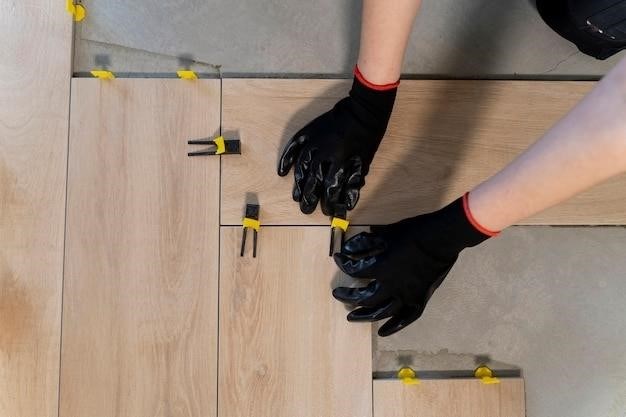Coretec Installation⁚ A Comprehensive Guide
This guide provides a comprehensive overview of COREtec flooring installation. It covers subfloor preparation‚ acclimation‚ installation methods (floating or glue-down)‚ necessary tools‚ step-by-step instructions‚ cutting techniques‚ expansion gap requirements‚ transitioning between rooms‚ troubleshooting‚ and post-installation care. Remember to consult the manufacturer’s instructions for your specific COREtec product. Always maintain the recommended expansion gap for optimal results and warranty validity.
Subfloor Preparation⁚ Ensuring a Level Base
A level subfloor is crucial for a successful COREtec installation. Before you begin‚ thoroughly inspect the subfloor for any imperfections. Address any significant issues like cracks‚ loose boards‚ or excessive moisture. For concrete‚ ensure it’s clean‚ dry‚ and level. Repair any cracks or imperfections using appropriate patching compounds and allow ample drying time. For wooden subfloors‚ ensure all boards are securely fastened and level. Unevenness should be addressed by sanding or using a self-leveling compound. The subfloor should be smooth and free of debris. Remember‚ a properly prepared subfloor prevents problems like squeaking‚ buckling‚ and unevenness in your new COREtec flooring. Consult the manufacturer’s guidelines for specific subfloor requirements and tolerances for your chosen COREtec product. Proper preparation guarantees a long-lasting and beautiful floor. Failure to properly prepare the subfloor may void your warranty.
Acclimation⁚ Preparing Coretec for Installation
Acclimating COREtec flooring to the room’s environment is a vital step before installation‚ although some COREtec products don’t require it. This process allows the planks to adjust to the temperature and humidity levels‚ preventing potential issues like expansion or contraction after installation. Open all sealed boxes of COREtec flooring and let them sit in the room where they will be installed for at least 48 hours‚ or as per the manufacturer’s instructions. The ideal temperature range is typically between 55°F and 85°F (13°C and 29°C). Ensure proper ventilation in the room to aid in the acclimation process. Avoid placing the flooring directly on a cold concrete slab. During acclimation‚ keep the flooring away from direct sunlight or heat sources. Proper acclimation ensures the planks are at the correct moisture content to prevent problems later. This minimizes the risk of expansion and contraction‚ resulting in a more stable and long-lasting floor installation. Neglecting acclimation could lead to issues later.
Choosing the Right Installation Method⁚ Floating vs. Glue-Down
COREtec flooring offers flexibility with two primary installation methods⁚ floating and glue-down. The floating method involves interlocking planks without adhesive‚ creating a system that allows for expansion and contraction. This method is generally easier for DIYers and suitable for most subfloors‚ provided they are adequately prepared and level. It’s important to maintain the recommended expansion gap around the perimeter of the room. The glue-down method‚ on the other hand‚ requires a suitable adhesive and a perfectly level subfloor. This approach offers superior stability and is often preferred in high-traffic areas or rooms with potential moisture issues. Choosing the right method depends on your skill level‚ subfloor condition‚ and the specific COREtec product you’ve selected. Always check the manufacturer’s instructions for recommendations based on your chosen COREtec line and subfloor type. Incorrect installation could void the warranty. Consider the pros and cons of each method before proceeding.

Tools and Materials⁚ Gathering Everything You Need
Before starting your COREtec installation‚ gather all necessary tools and materials. For both floating and glue-down methods‚ you’ll need a measuring tape‚ pencil‚ safety glasses‚ and a pull bar or tapping block. A utility knife or flooring saw is essential for cutting planks to size. For floating installations‚ spacers are crucial to maintain the necessary expansion gap. A rubber mallet can help with the click-lock system. If using the glue-down method‚ you’ll need a suitable adhesive‚ a notched trowel for even application‚ and possibly a roller to ensure proper adhesion. Additional tools might include a knee kicker for easier plank placement and a moisture meter to verify subfloor dryness. Don’t forget to check the manufacturer’s instructions for specific recommendations on tools and materials for your COREtec product line. Having all materials ready beforehand streamlines the installation process‚ ensuring a smooth and efficient experience.
Step-by-Step Installation Guide⁚ A Detailed Walkthrough
Begin COREtec installation by establishing a starting point along the longest wall‚ ensuring a minimum ¼-inch expansion gap. For floating installations‚ use spacers to maintain this gap consistently. Lay the first row of planks‚ locking them together using the appropriate method (click-lock‚ angle-tap‚ etc.) as specified by your COREtec product’s instructions. Continue laying planks in subsequent rows‚ ensuring tight connections. Use a tapping block and mallet to avoid damaging the planks. For glue-down installation‚ apply adhesive according to the manufacturer’s directions using a notched trowel‚ ensuring even coverage. Carefully position each plank and firmly press it into place. Check for consistent expansion gaps throughout the installation. Cut planks as needed to fit around obstacles‚ using a utility knife or flooring saw for precise cuts. Remember to always maintain the recommended expansion gap around the perimeter of the room. Regularly check your work to ensure proper alignment and secure connections. Consult the manufacturer’s video tutorials for visual guidance‚ if available.
Cutting and Fitting⁚ Precision Techniques for a Seamless Look
Precise cutting is crucial for a professional finish with COREtec flooring. For straight cuts‚ utilize a sharp utility knife or a flooring saw‚ ensuring a clean‚ straight line. Score the plank deeply before snapping it to avoid chipping. For intricate cuts around pipes or other obstacles‚ use a jigsaw with a fine-tooth blade for accurate maneuvering. Measure twice and cut once to minimize waste and ensure a perfect fit. When cutting planks for fitting around doorways or other irregular shapes‚ use a pencil to mark the exact dimensions. Employ a combination square or speed square for perfectly aligned cuts. A circular saw with a fine-tooth blade can be used for larger cuts‚ but use caution to avoid damage. For curved cuts‚ use a jigsaw or coping saw‚ guiding the blade carefully. Always test your cuts on a scrap piece of flooring before cutting the actual planks. If necessary‚ use a sanding block to smooth any rough edges after cutting‚ ensuring a seamless transition. Remember‚ precise cuts and careful fitting are paramount to achieving a professional and aesthetically pleasing installation.
Expansion Gaps⁚ Allowing for Movement and Preventing Damage
Maintaining proper expansion gaps is critical for preventing damage to your COREtec flooring. These gaps accommodate the natural expansion and contraction of the material due to temperature and humidity fluctuations. Failure to leave adequate spacing can lead to buckling‚ warping‚ or other issues that may void your warranty. The recommended expansion gap is typically 1/4 inch (6mm) around the perimeter of the room and between the flooring and any fixed objects like walls‚ baseboards‚ and door frames. Use expansion gap spacers throughout the installation process to maintain consistent spacing. These spacers are readily available at most flooring retailers. Ensure that the spacers remain in place until the adhesive has fully cured (if using a glue-down method). Properly installed expansion gaps allow the flooring to move freely without stress‚ protecting your investment. Neglecting this crucial step can lead to costly repairs and potential damage. Accurate spacing ensures the longevity and aesthetic appeal of your COREtec floor. Consult the manufacturer’s specific instructions for your chosen COREtec product line for precise expansion gap requirements.
Transitioning Between Rooms⁚ Managing Different Flooring Types
When installing COREtec flooring in multiple rooms or areas with different flooring types‚ proper transitioning is essential for a seamless and aesthetically pleasing finish. This involves using transition strips or reducers designed to bridge the gap between your COREtec floor and other flooring materials such as carpet‚ tile‚ or hardwood. These transitions not only create a smooth visual flow but also prevent tripping hazards and protect the edges of the flooring. Select transition strips that match the color and style of your COREtec flooring for a cohesive look. Proper installation involves accurately measuring the height difference between the flooring types to ensure a snug and secure fit. Follow the manufacturer’s instructions for installing the specific transition strip you’ve chosen. Some transitions may require adhesive‚ while others utilize a simple interlocking mechanism. Always ensure the transition strip is firmly secured to prevent movement or damage. Pre-planning the transition points before starting installation will help ensure a smooth and professional-looking outcome. Using appropriate transitions enhances the overall appearance and functionality of your newly installed COREtec flooring.

Troubleshooting Common Issues⁚ Addressing Problems During Installation
During COREtec installation‚ several common issues might arise. Uneven subfloors can cause clicking or gaps between planks; ensure a level subfloor before starting. Difficulty locking planks together may indicate improper alignment or damaged planks; double-check alignment and replace damaged pieces. Clicking sounds after installation could be due to insufficient expansion gaps; ensure proper spacing around the perimeter. If planks buckle or warp‚ this often points towards improper acclimation or high humidity; check environmental conditions. Uneven transitions between rooms may result from incorrect installation of transition strips; carefully follow manufacturer’s instructions. For significant problems‚ consult the manufacturer’s warranty information and contact customer support. Before beginning large-scale installations‚ practice on a small area to get comfortable with the process. Remember to always inspect planks for damage before installation; replace any defective pieces immediately. By proactively addressing these potential problems‚ you can ensure a successful and long-lasting COREtec floor installation.
Post-Installation Care and Maintenance⁚ Preserving Your New Floor
Proper care and maintenance are crucial for preserving the beauty and longevity of your COREtec floor. Regular sweeping or vacuuming removes loose dirt and debris‚ preventing scratches. For spills‚ promptly blot up liquids with a clean cloth; avoid scrubbing. Use a pH-neutral cleaner specifically designed for vinyl flooring‚ diluted according to the manufacturer’s instructions. Avoid abrasive cleaners‚ scouring pads‚ or harsh chemicals‚ which can damage the surface. Place protective felt pads under furniture legs to prevent scratches and dents. Avoid dragging heavy objects across the floor. For deeper cleaning‚ you can use a damp mop with a pH-neutral cleaner; ensure the floor is completely dry afterward to prevent moisture damage. Regularly inspect the floor for any signs of damage or wear and address them promptly. Consider using area rugs in high-traffic areas to further protect the flooring. By following these simple maintenance steps‚ you can ensure that your COREtec floor remains beautiful and functional for years to come. Remember to consult the manufacturer’s specific care and maintenance guidelines for your particular COREtec product line.